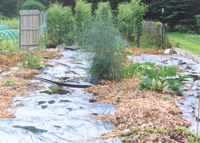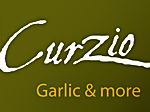
We have created this special e-news page to keep you up-dated on our garlic crop of 2004.
Many readers of our e-news know that we sell out of our garlic crop before we harvest and therefore place an early order to reserve their favorite varieties.
My vegetable garden is divided in four sections. This year the bulbs are growing in the South/West section. Four rows, 50 ft. long.
The soil has not been tilled for 2 years.
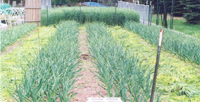
Last year I've tried something new: A spacing of 4 ft. between two rows has been sowed with winter rye. This area will be used for the transplanting of the zucchini seedlings.
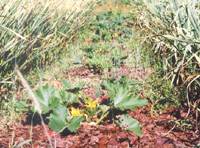
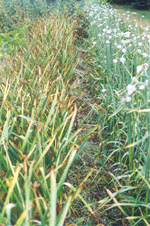
In June the hardneck garlic varieties grow a seed scape that should be removed. You want the plant to direct its energy to grow a larger bulb, not larger seed.
As an exception, we let the Russian Red garlic develop the seed scape. We harvest these bulbils to saw in the fall for Spring Garlic.
Notice how the garlic without seed scapes [left] dries the leaves faster than the garlic that still is developing the seed scapes.
Different varieties develop smaller or larger bulbils. We have selected the Russian Red for its large bulbils.
See a comparison of Russian with Armanian bulbils. Clearly the Russian bulbils will develop into larger Spring Garlic.
Spring Garlic is harvested earlier in the season - as soon as May - and comes with only one, round clove. This clove would develop into a bulb with many cloves, if left in the ground for an other year.


There are hundreds of varieties, hard- and softneck, but chefs prefer hardneck varieties for the higher flavor.
When customers ask me: what is the difference between these varieties? I like to answer with an other question: how do you cook with garlic?
As it is more interesting to make an intelligent choice based on the use of this spice!
Still one can put friends and family through the experience of eating several bulbs of raw garlic to rate the heat [I owe big time to my wife + brother and sister-in-law].
The flavor is something else. As we have experienced that Italian Purple is a mild heat variety that explodes of flavor cooked. While the Romanian, for instance, has more heat raw, but caramelize to a smooth paste [350 degrees oven, 40 min. ]
The third factor is the size of the cloves. If you frequently use a garlic press, very large cloves are not the best choice. I prefer very large cloves cut in halves in my sauces. The garlic juices will leak into the sauce and the cooked piece of garlic is delicious to eat.
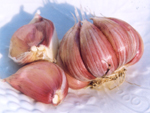
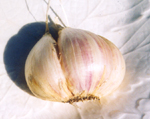
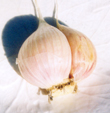
- Heat 3
- Flavor: intense
- Cloves: M - S
- Great for sauces
- Heat 4
- Flavor: tart
- Cloves: M - L
- Great raw in salads
- Heat 5
- Flavor: smooth
- Cloves: XL
- Great roasted
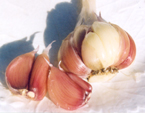
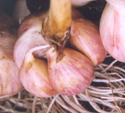
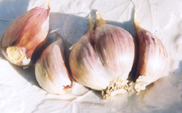
- Heat 9
- Flavor: strong
- Cloves: M - L
- Great roasted
- Heat 6
- Flavor: sharp
- Cloves: M - S
- Great for sauces
- Heat 8
- Flavor: smooth
- Cloves: M - L
- Great roasted
Planted in the fall and harvested in July, this variety of onions has a strong compound that preserves the bulbs for a long time. It is paramount to purchase well cured bulbs, if you wish to use them through the winter, well into spring.
Great cooked or raw. I use it often raw as an extra-mild substitute for garlic in tomato or bean salads.
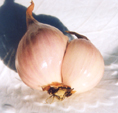
- Mild
- 2 - 3 cloves
- Great for salads
The area where the garlic was harvested is now covered with plastic to preserve the compost-enriched soil for the crop that will follow the next spring.
The tomatoes are growing in the fenced-in garden section in the back. At the end of September the tomato vines will be done and in October the garlic seed will be planted in that garden section, following a counter-clockwise rotation.
